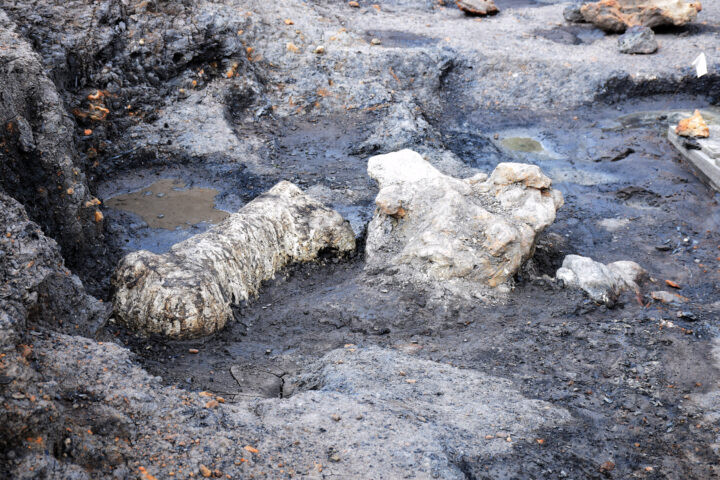News
Rare Dinosaur Fossils Discovered at M-NCPPC, Department of Parks and Recreation, Prince George’s County Dinosaur Park
July 12, 2023

FOR IMMEDIATE RELEASE: July 13, 2023
Media Contact: Angel Waldron, 301-446-3311
Rare Dinosaur Fossils Discovered at M-NCPPC, Department of Parks and Recreation, Prince George’s County Dinosaur Park
First of its Kind Found in Maryland since 1887
LAUREL, Md. – M-NCPPC, Department of Parks and Recreation, Prince George’s County paleontologists and volunteers discovered the largest theropod fossil in Eastern North America during a dig experience program at the Dinosaur Park on April 22, 2023. Additional fossils found nearby elevate the Dinosaur Park’s classification to a “bonebed.” The term “bonebed” is used by paleontologists when bones of one or more species are concentrated within a geologic layer. This is the first dinosaur bone bed discovered in Maryland since 1887.
“Finding a bonebed like this is a dream for many paleontologists as they can offer a wealth of information on the ancient environments that preserved the fossils and provide more details on the extinct animals that previously may have only been known from a handful of specimens,” said JP Hodnett, M-NCPPC, Department of Parks and Recreation, Prince George’s County Dinosaur Park Paleontologist and Program Coordinator. “Most paleontologists have to travel across the country or go overseas to find something like this, so having this rare find so close to home is fantastic!”
Hodnett made the initial discovery and classified the 3-foot-long shin bone as a therapod, a branch of the dinosaur family that contains carnivorous dinosaurs such as Tyrannosaurus rex. His initial hypothesis of this fossil is an Acrocanthosaurus, the largest theropod in the Early Cretaceous period, estimated to measure about 38 feet long. Acrocanthosaurus teeth have been previously collected from Dinosaur Park.
“Dinosaur fossils are exceptionally rare in the eastern US, and among these only Maryland has produced dinosaurs from the Early Cretaceous Period. Typically, only one or two bones are found at a time, so this new discovery of a bonebed of fossils is extremely important. It is certainly the most significant collection of dinosaur bones discovered along the eastern seaboard in the last hundred years,” said Matthew Carrano, a paleontologist with the Smithsonian.
University of Maryland Paleontologist Thomas Holtz, the first to verify the therapod discovery at the park, said “The dinosaur site at Laurel is by far the most important dinosaur dig site in America east of the Mississippi. It is historically significant, as it was one of the first dinosaur fossil sites found in the U.S. More importantly, it gives us insights into the diversity of animals and plants at a critical period in Earth’s history.”
The first fossil found in the bonebed was a four-foot-long limb bone encased in ironstone of a large dinosaur, the identification is unknown at this time. Additional ancient plant and animal fossils found between 2018 to present include:
- Priconodon, a large, armored dinosaur – teeth, osteoderms, and vertebra
- Sauropod (Long Necked plant-eating dinosaur, 60-70 feet long), possibly Astrodon – one tail vertebra
- Ornithomimoid, ostrich-like dinosaur- ankle bone, claw, and a vertebra
- Large theropod, possibly Acrocanthosaurus– 3-foot-long shin bone from a 35+ foot long meat-eating dinosaur
- Deinonychus, a bird-like predatory dinosaur and larger Velociraptor-relative- tooth
- Small tyrannosaur, early T. rex relative and first evidence of this group in Maryland, potential oldest in Eastern North America- tooth
- Small theropod (coelurosaur), chicken-sized meat-eating dinosaur and distant relative to T. rex- thigh bone
- Crocodile- tooth
- Turtle- multiple shell segments and limb bones, possibly more than one individual.
- Stingray, oldest North American fossil representative, 2nd oldest globally – tail barb.
- Coprolites- fossilized animal feces
- Large freshwater clam
- Large, carbonized conifer wood log segments
- Carbonized seed cone clusters
“This discovery marks an extraordinary milestone in the field of paleontology and opens a window into the ancient world and species that once roamed this land millions of years ago,” said Peter A. Shapiro Chairman of The Maryland-National Capital Park and Planning Commission. “We are proud of our dedicated team of experts at the Department of Parks and Recreation, Prince George’s County, and their ongoing efforts in preserving and studying our natural heritage.”
The Dinosaur Park located in Laurel, Maryland is a property of the Maryland-National Capital Park and Planning Commission (M-NCPPC). M-NCPPC, Department of Parks and Recreation, Prince George’s County provides a variety of educational experiences where the public can assist Dinosaur Park staff and be paleontologists for a day. Fossils found at the park are 115 million years old (Early Cretaceous period), occurring approximately 50 million years before the Tyrannosaurus Rex. The area represents what remains of an Early Cretaceous period river and wetlands, similar in environment to the Patuxent River Park in Upper Marlboro, Maryland today.
The fossils found will be excavated out of the field, cleaned, examined, and cataloged into the Department’s museum system.
To learn more about Dinosaur Park and its programs visit pgparks.com.
About the Department
The M-NCPPC, Department of Parks and Recreation delivers an award-winning park system through progressive, innovative leadership and a commitment to the community and the environment in Prince George’s County. The Department of Parks and Recreation encourages and supports the participation of individuals with disabilities in all programs and services. Register at least a minimum of two weeks in advance of the program start date to request and receive disability accommodation. For more information on the Department, visit www.pgparks.com.



